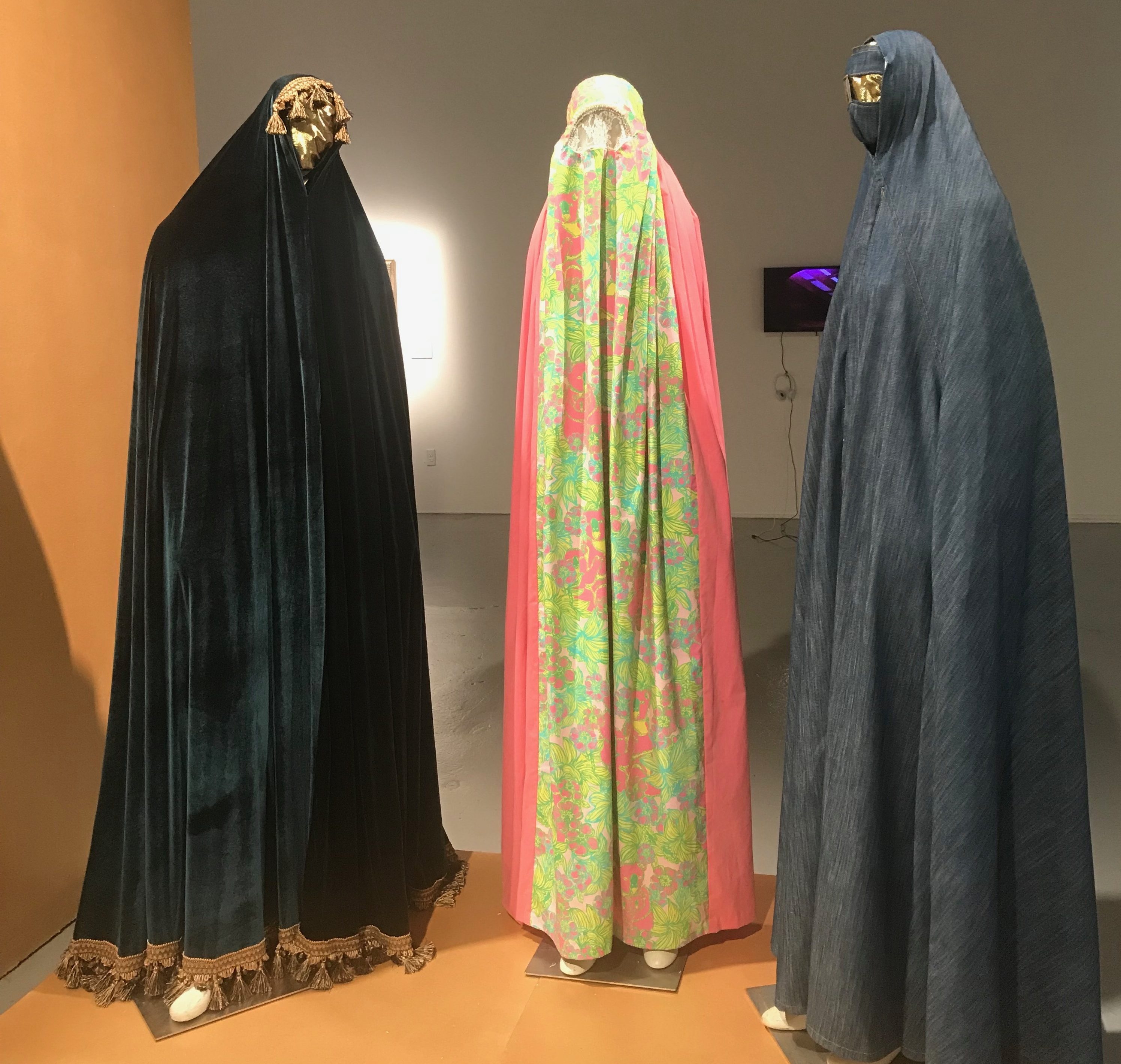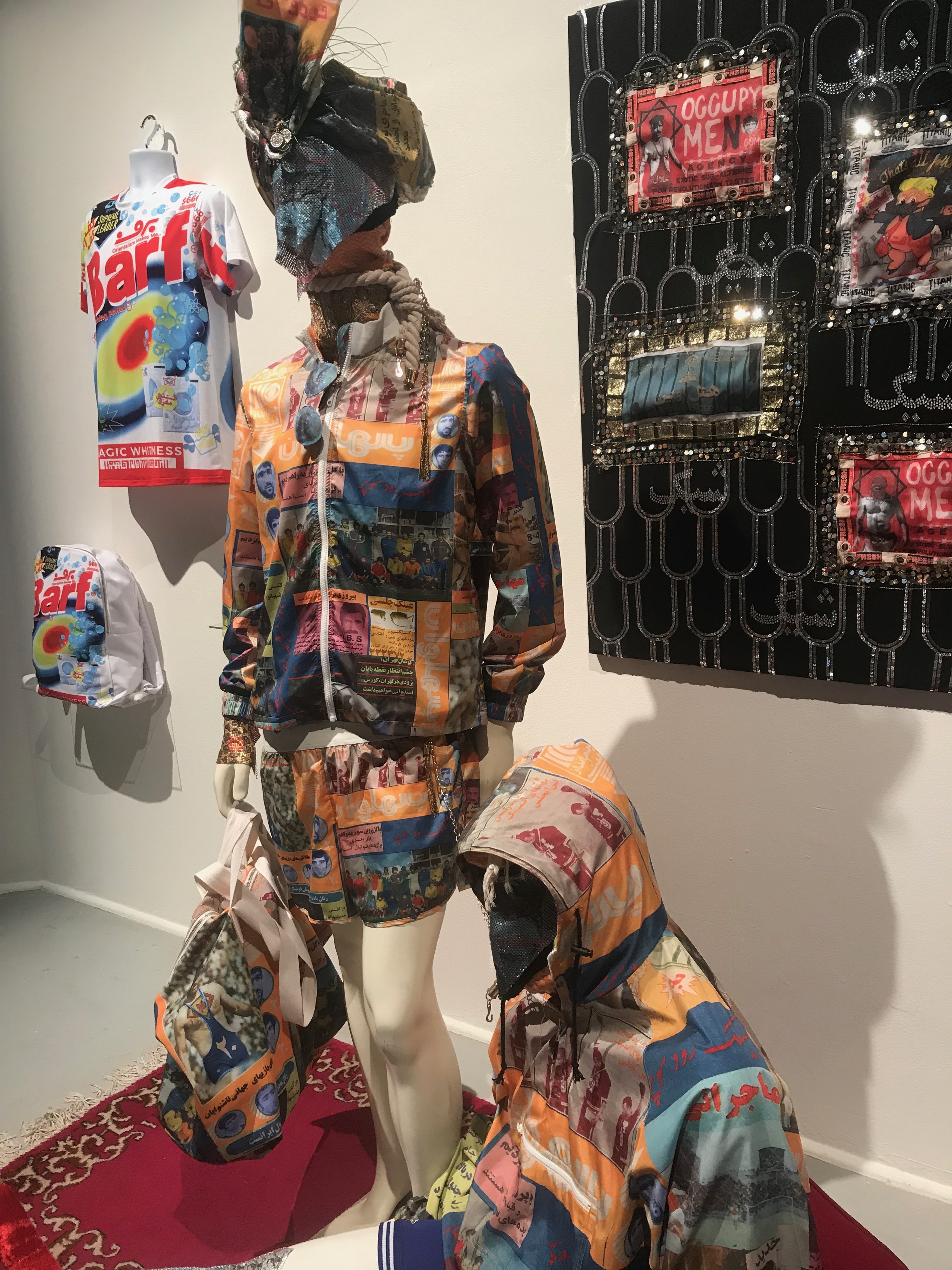Islam, Art, and Intersectional Identity

Until recently, when I thought of Islamic art I thought immediately of structures like the Mezquita in Cordoba, Spain. Now a functioning Cathedral located in Andalusia, but originally a mosque built on the site of a Roman temple in 784 A.D., the building is an architectural palimpsest reflecting how the history of war, invasion, and religious conquest is visible in the built environment. The Mezquita is a structure where the meeting of Islam and the West are not only visible, but where the history of their mutual engagement is clarified and reinforced through its architecture and stylistic flourishes.
When I first visited the Mezquita in the early 2000s, I was fascinated by its candy cane-striped pillars, its geometrically perfect honeycombed ceilings, and the ornately scrawled words of al-Fatihah, the opening surah of the Qur’an, etched in nearly illegible Arabic calligraphy on its arches. Islamic art galleries from the Metropolitan Museum of Art in New York to the British Museum in London focus on these repeated features, displaying a variety of art from the Middle East, North Africa, and South Asia. But as the politics of power, racial identity, and religious and national belonging changed over millennia, so did the artistic expressions of Muslims’ experiences of those political interactions. Muslims migrated outside of these traditionally Muslim regions, establishing roots throughout the world. How have their experiences created unique representations of their political activism, racial identities, and religious practices, especially in the United States?
On January 25, 2018, a temporary exhibition opened at the SOMArts Cultural Center in San Francisco. Curated by two queer, gender non-conforming Muslim-American artists, Zulfikar Ali Bhutto and Yas Ahmed, The Third Muslim was a multi-media and multi-sensory art exhibition featuring the work of fourteen Muslim artists from throughout the Muslim diaspora. In Ahmed and Bhutto’s words, the exhibit was intended to “create a platform [promoting the] visibility of artists within the queer, trans*, and gender non-conforming Muslim community” and “to build an archive of collective and individual stories of [these Muslims] claiming space.” The exhibit dealt with issues of Islamophobia, gender oppression, patriarchy, colorism, and racism. It was curated with attention to the ways that the identity politics of queer Muslims of color are influenced by the intersection of colonialism, racial capitalism, and patriarchal oppression. The point, according to Bhutto and Ahmed, was to bring queer, trans*, and gender non-conforming Muslims out from their position in the “margins among margins.” By promoting “socially engaged art created by and for queer and trans* Muslims” Ahmed and Bhutto sought to challenge gender-based oppression, racism and Islamophobia within mainstream queer, trans*, and Muslim communities.
The exhibit website, the backgrounds of the curators and artists as activists for racial and gender justice, and the exhibition itself immediately signaled to visitors that this was not the Metropolitan Museum’s Islamic art. Instead of being greeted by fountains, courtyards, candy-striped columns, and al-Fatihah, viewers entered the space and were welcomed by an installation by Saba Taj. Taj, a Pakistani-American Muslim artist from North Carolina, draped three mannequins, all ideal fashion model height and dimensions at 5’7” tall, in denim, floral, and velvet burqas. The right-most mannequin, dubbed Relaxed Fit, played on the association between all-American identity and denim. Instead of curve-hugging Levi’s, Taj fashioned a burqa out of the material, cloaking the mannequin from head to toe.
Over the eyes and face, the mannequin peered out from a gold mesh. Anthropologist Lila Abu-Lughod has argued that after the 2001 U.S. invasion of Afghanistan, the burqa, a traditional Pashtun style of covering, was mobilized by the American media as the ultimate symbol of Muslim women’s oppression, backwardness, and most importantly, as a justification for America’s invasion of Afghanistan. Attendant with these justifications are American neo-imperial assertions of Western cultural superiority and dismissal of the existence of Third World and Muslim feminisms. Thus, the American media makes a distinction between Islam and feminism, Islam and progress, and between Islam and liberation. Taj challenges this misconception through her art, critiquing the separation between Islam and American identity by fusing the burqa, an ostensibly anti-American symbol, with denim fabric, a quintessentially American symbol. At the same time, she pushes back against predominant notions of femininity and feminism, questioning the progressiveness of Western feminist discourse.

This theme of fashioning the Muslim body recurred throughout the Third Muslim, and has previously proven itself to be a successful strategy for oppressed communities. As English scholar Saidiya Hartman and late historian Stephanie M. H. Camp have argued, it has been a way that oppressed minorities have asserted everyday resistance against racial injustice and restrictions on physical and social mobility. In this vein, Nabeela Vega’s photo series Visiting Thahab challenged conceptions of enjoyment and freedom by depicting a woman in a gold lamé burqa enjoying herself in various settings. In one photograph, the woman sits on a rock by the ocean enjoying the sea spray and kicking her feet playfully. The unusual choice of fabric and depictions of pleasure and enjoyment challenge monolithic representations of freedom and feminist self-expression.
In addition to these assertions of Muslim and Third World feminisms through pleasure and self-fashioning, the Third Muslim is remarkable for the way that fashioning the Muslim body is presented as a challenge to racial hierarchy, colonization, and oppression. Iranian artist Hushidar Mortezale’s Occupy Me: Topping from the Bottom, literally occupied almost an entire wall along the exhibit hall depicting a red carpet fashion show of figures in hijabs, turbans, and hooded sweatshirts sewn from brightly colored fabric printed with Farsi script. Behind these figures, Mortezale created a “Step and Repeat” with what at first glance appeared to be ads for commercial businesses. The advertisements, however, had been distorted. In a parody of a KFC advertisement, Mortezale took the KFC logo and replaced the Colonel with a hooded KKK figure. In an ad for washing powder screen printed on a t-shirt, Mortezale made a comment on Orientalism, white supremacy, and internalized self-hatred with the words “Orientalism makes me Barf.” Underneath, he beseeched the reader to recognize the “brainwashing power” of white supremacist ideology. Mortezale and the other artists in this exhibit do in practice what Mortezale’s provocative title, which plays on gay male sexual dynamics, suggests – that they assert their power from the bottom. In some cases, such as in Samra Habib’s photographic series, Just Me and Allah, literal visibility is given to Black and brown queer Muslim subjects.

I will defer to my art historian and performance studies colleagues to continue to unpack the nuances of the performative and artistic aspects of these intersectional representations. As a historian of the Muslim diaspora and African diasporic experience, however, I highlight the case of the Third Muslim as a radical act of resistance. The Third Muslim sought to actively claim space for queer, trans* and gender non-conforming artists of all colors and origins. In my January post, I argued that more spaces needed to be created to address historic discrimination against Muslims of African descent and to implement in practice the sweeping claims to equality and justice reflected in the Qur’an. The same is true for lesbian, gay, trans*, and gender non-conforming Muslims, particularly those of color. Scholars like Scott Siraj al-Haqq Kugle have begun to privilege these voices in scholarship, allowing gay, lesbian and transgender Muslims to speak out about how they understand themselves as Muslims, express themselves, and create spaces for sexual and affectionate expression in a variety of relationships. As Ahmed noted, “we’ve always been here and are just claiming our rightful space within Islam.”
Ahmed and Bhutto also engaged in a radical act by creating an archive curated by queer Muslims of color for queer Muslims of color. The Muslims represented in Ahmed and Bhutto’s exhibition claim origins in Iran, Pakistan, Somalia, and Morocco among others. They are American-born and immigrant. They have both created space for themselves as American and rejected American identity. In this short post, I have not been able to do sufficient justice to the brilliant work of all of the artists who were exhibited in the Third Muslim. Historians of populations that have been marginalized often struggle with the issue of how to recover the experiences, political activism, and cultural productions of individuals whose voices have been erased. This archival production is not perfect because it cannot be. But as Michel-Rolph Trouillot has taught us, the production of all archives are representations of power. That does not reduce the power of the Third Muslim as a leap in a progressive direction, but it signals that more work need be done and more progress must be made. The Third Muslim closed on February 22, 2018, but its intentions and radical project will live on through the art of its exhibitors and the existence of this archive of experience, representation, and expression.
Copyright © AAIHS. May not be reprinted without permission.